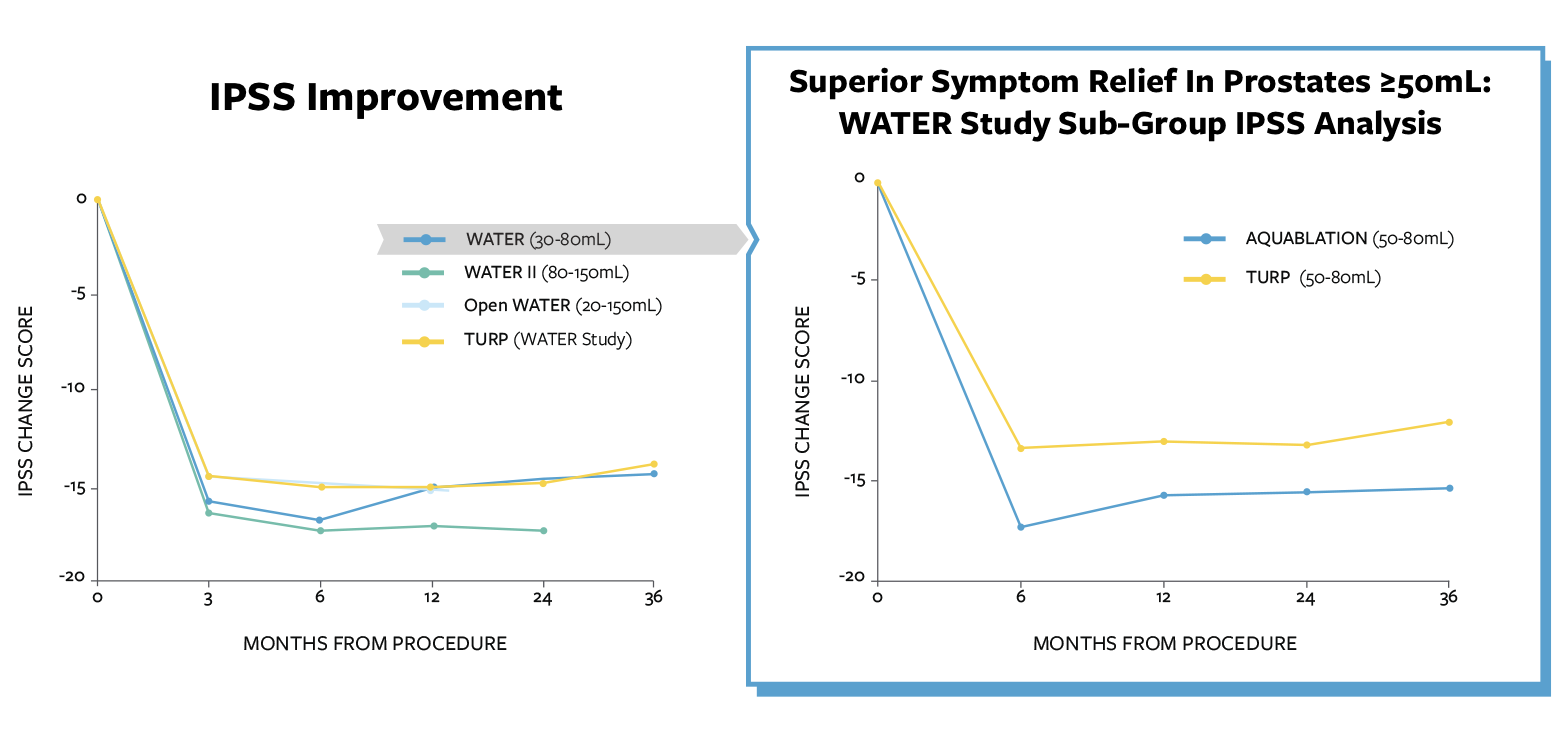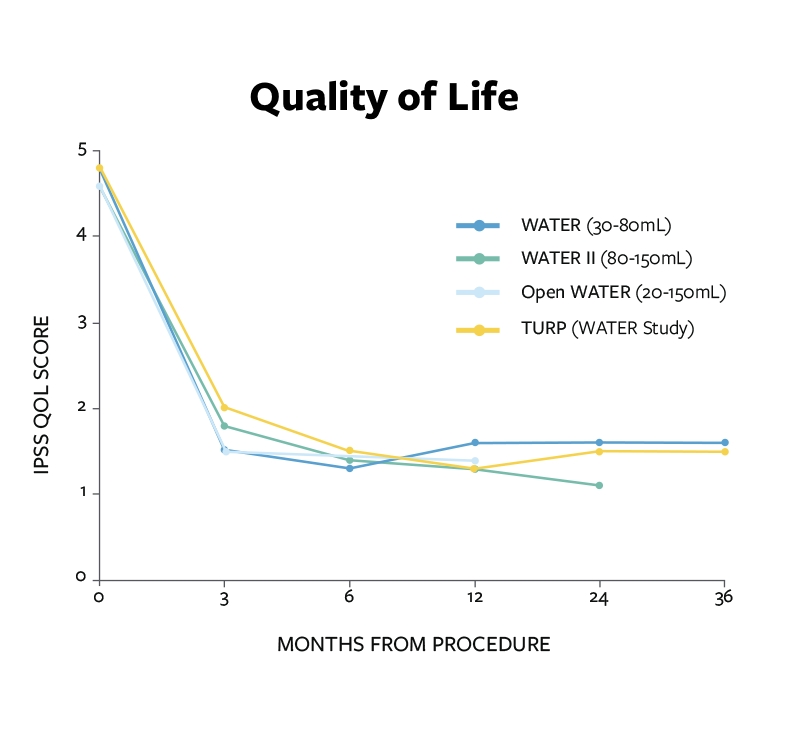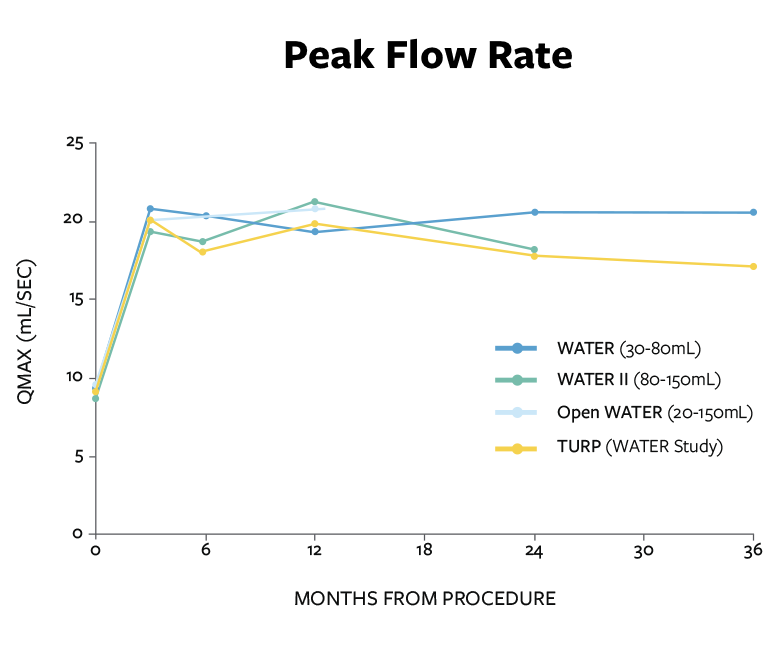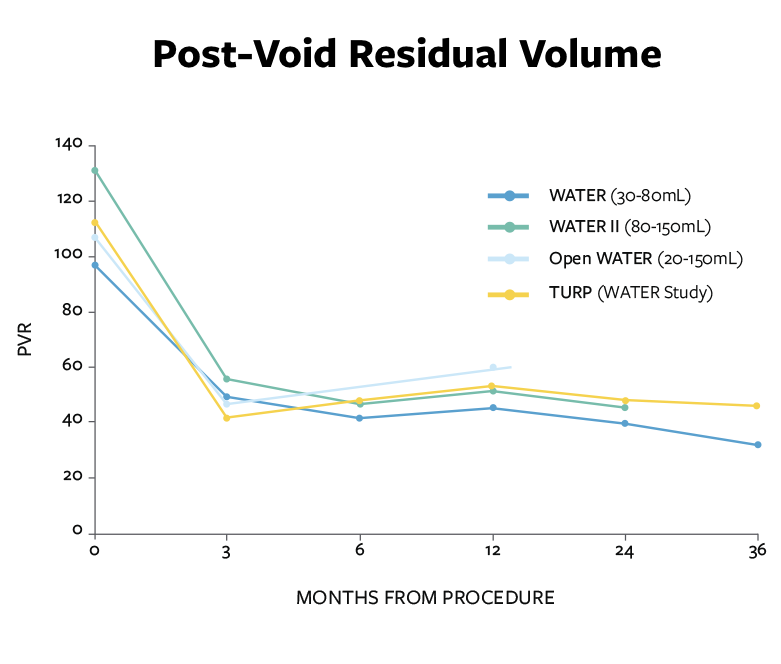Clinical Data on Aquablation Therapy
OVERVIEW
PROCEPT BioRobotics is committed to delivering clinical excellence and has supported the execution of several studies evaluating Aquablation therapy and the AquaBeam Robotic System. The robust body of clinical data is based on two pivotal studies, follow-on commercial studies, and several independent studies. The multiple-year follow-up data from the WATER, WATER II, and OPEN WATER studies for prostates ranging from 20-150 mL support the safety, efficacy, and durability of Aquablation therapy as a solution for benign prostatic hyperplasia (BPH).1,2,3
A summary of the three major studies evaluating Aquablation therapy is detailed below.
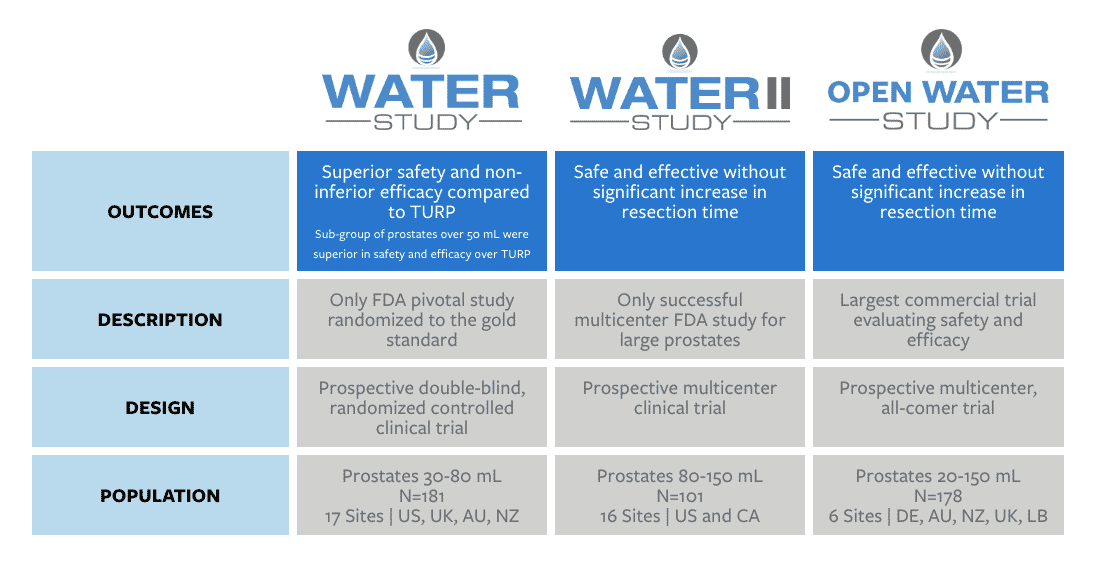
SAFETY
Low Rates of Irreversible Complications Across Prostates of All Shapes and Sizes
The safety profile of Aquablation therapy is characterized by the incidence of irreversible complications, such as erectile dysfunction, ejaculatory dysfunction, and incontinence.
Aquablation therapy demonstrated low rates of irreversible complications across three major studies with varying patient profiles, varying patient profiles, prostate sizes and shapes, and surgeon experience. 1,2,3
Aquablation therapy delivers best-in-class safety results by enabling surgeons to:
- Visualize and preserve key anatomical structures associated with sexual and urinary function, such as the bladder neck, verumontanum, and external sphincter.
- Customize the resection contour to each patient’s anatomy to optimize tissue resection and anatomical preservation.
SAFETY
Low Rates of Irreversible Complications Across Prostates of All Shapes and Sizes
The safety profile of Aquablation therapy is characterized by the incidence of irreversible complications, such as erectile dysfunction, ejaculatory dysfunction, and incontinence.
Aquablation therapy demonstrated low rates of irreversible complications across three major studies with varying patient profiles, varying prostate sizes and shapes, and different surgeon experiences.1,2,3
Aquablation therapy delivers best-in-class safety results by enabling surgeons to:
- Visualize and preserve key anatomical structures associated with sexual and urinary function, such as the bladder neck, verumontanum, and external sphincter.
- Customize the resection contour to each patient’s anatomy to optimize tissue resection and anatomical preservation.
EFFICACY
Best-In-Class, Durable Results Across Prostates of All Shapes and Sizes
Efficacy following a BPH procedure is determined by symptom reduction and quality of life improvement.
The efficacy of Aquablation therapy is characterized by change in BPH symptom scores, urinary flow rates, and quality of life scores at each follow-up point.
- The WATER data revealed that Aquablation therapy has a similar symptom reduction and quality of life improvement to transurethral resection of the prostate (TURP) at all follow-up points.1
- Analysis of a patient subgroup within the WATER study of patients with prostates above 50 mL revealed that Aquablation therapy was superior in symptom reduction as compared to TURP.1
- WATER II evaluated Aquablation therapy specifically in large prostates, showing best-in-class symptom reduction.
The symptom reduction and quality of life improvement observed across the WATER, WATER II, and OPEN WATER studies demonstrates the size and shape-independent efficacy of Aquablation therapy.1,2,3 The low retreatment rates from the three studies support the durability in efficacy results of the procedure.
Efficacy data from all three studies characterized by metrics such as IPSS, IPSS quality of life, post-void residual volume, and peak flow rate over a 36 month follow up are displayed below. Click on the charts below to enlarge the image.

The WATER Study (Waterjet Ablation Therapy for Endoscopic Resection of prostate tissue), set out to challenge the industry gold standard, transurethral resection of the prostate (TURP) in treating benign prostatic hyperplasia. The bold study design examined the safety and efficacy of resecting prostates 30 – 80 mL in a double-blind, prospective, randomized controlled clinical trial.
The landmark results of the WATER study concluded that Aquablation therapy is superior in safety and non-inferior in efficacy to TURP. Aquablation therapy significantly reduced the rate of irreversible complications driven by ejaculatory dysfunction and matched improvement in symptom score, urinary flow rate, and residual urinary volume.
Analysis of a patient subgroup with prostates above 50 mL revealed that Aquablation therapy was superior in safety and symptom reduction. This favorable data encouraged a study on larger prostates.
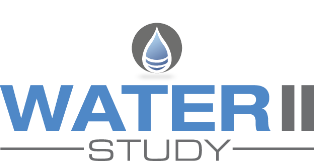
The WATER II study evaluated the safety and efficacy of Aquablation therapy on prostates 80 – 150 mL in a single arm, prospective, clinical trial. As the only successfully completed study to assess treatment among large prostates, the WATER II study concluded that Aquablation therapy significantly improved symptom scores and urinary flow rates.
The results from WATER and WATER II depict the size independence of Aquablation therapy and durability of outcomes out to two years. Conclusion of these clinical studies prompted assessment in a commercial setting to validate results.

OPEN WATER is the first multicenter all-comer study conducted in a commercial setting spanning patients with prostates between 20 and 150 mL. The results validated clinical study outcomes in a real-world setting and supported the size and shape independence of the therapy.

The WATER Study (Waterjet Ablation Therapy for Endoscopic Resection of prostate tissue), set out to challenge the industry gold standard, transurethral resection of the prostate (TURP) in treating benign prostatic hyperplasia. The bold study design examined the safety and efficacy of resecting prostates 30 – 80 mL in a double-blind, prospective, randomized controlled clinical trial.
The landmark results of the WATER study concluded that Aquablation therapy is superior in safety and non-inferior in efficacy to TURP. Aquablation therapy significantly reduced the rate of irreversible complications driven by ejaculatory dysfunction and matched improvement in symptom score, urinary flow rate, and residual urinary volume.
Analysis of a patient subgroup with prostates above 50 mL revealed that Aquablation therapy was superior in safety and symptom reduction. This favorable data encouraged a study on larger prostates.

The WATER II study evaluated the safety and efficacy of Aquablation therapy on prostates 80 – 150 mL in a single arm, prospective, clinical trial. As the only successfully completed study to assess treatment among large prostates, the WATER II study concluded that Aquablation therapy significantly improved symptom scores and urinary flow rates.
The results from WATER and WATER II depict the size independence of Aquablation therapy and durability of outcomes out to two years. Conclusion of these clinical studies prompted assessment in a commercial setting to validate results.

OPEN WATER is a prospective multicenter all-comer study conducted in a commercial setting spanning patients with prostates between 20 and 150 mL. The results validated clinical study outcomes in a real-world setting and supported the size and shape independence of the therapy.
References
Aquablation Therapy Resources
Aquablation Therapy
AquaBeam Robotic System
